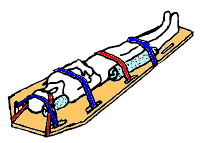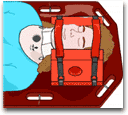Emergency Treatment
Signs and Symptoms of Possible Spinal Cord Injury
• Extreme pain
or pressure in the neck, head or back
• Tingling or loss of sensation
in the hand, fingers, feet, or toes
• Partial or complete loss
of control over any part of the body
• Urinary or bowel urgency,
incontinence, or retention
• Difficulty with balance and walking
• Abnormal
band-like sensations in the thorax - pain, pressure
• Impaired
breathing after injury
• Unusual lumps on the head or spine
Ask the patient to grip your fingers with both hands and wiggle their feet
SPINAL STABILIZATION / IMMOBILIZATION SUMMARY
• Provide manual
in-line immobilization
• Evaluate patient's responsiveness, ABCs,
need for immediate resuscitation and check motor,
sensory and circulation in all four extremities. 
• Examine the patient's neck and apply
cervical collar
• Immobilize the patient's torso to the selected
immobilization device such that the torso cannot move up, down, left
or right.
• Evaluate torso straps and adjust as needed.
• Place
an appropriate amount of padding behind head if needed for adult patients
and under the thorax for pediatric patients (age 7 yrs or under) to maintain
in-line spinal immobilization.
• Immobilize the patient's head.
• Once
patient is immobilized, secure patient's arms and legs to the board or
immobilization device.
• Reevaluate patient's responsiveness,
ABCs, need for immediate resuscitation and check motor, sensory and circulation
in all four extremities.
The Principles of Spinal Motion Restriction should include:
(a) manual
motion restriction of the head and neck while assessing the ABC's;
(b) placement of the head and neck in neutral position when possible and
not contraindicated;
(c) immobilization on a rigid spine board, with the
use of an appropriately sized cervical extrication collar, a cervical immobilization
device (C.I.D.) to anchor the head to the board, and an appropriate strapping
system to secure the body to the board.
IMMOBILIZE
THE SPINE AND
PREVENT FURTHER
HARM
